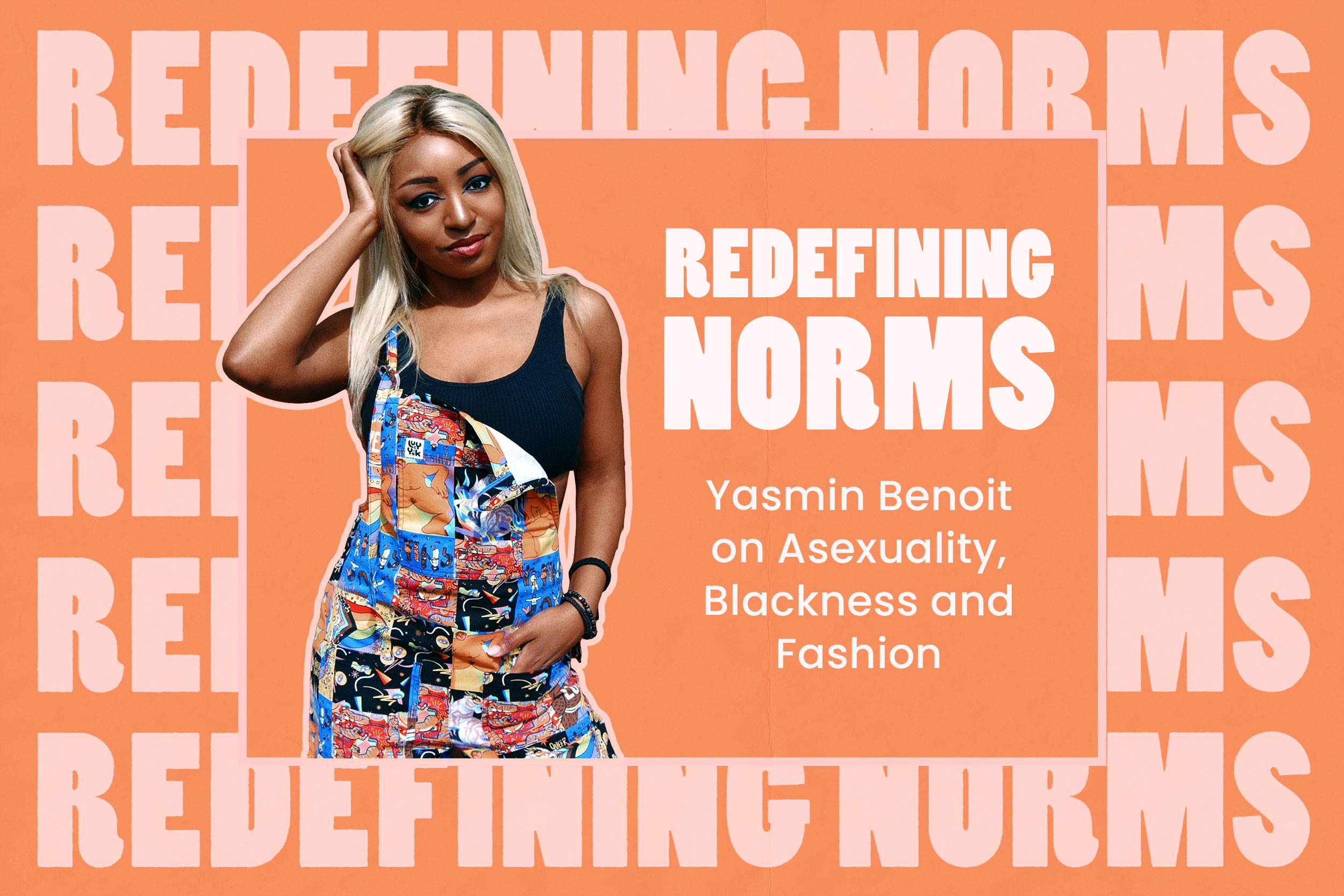Redefining Norms: Yasmin Benoit on Asexuality, Blackness and Fashion
Clothing can be controversial, depending on who you are and how you do it. A lot of people know me because of how I dress. Some knew me because of my affinity for alternative and gothic-inspired fashion. Others have seen me blowing up online because people are upset about the length of my skirt or the visibility of my bra. Clothing has unwittingly become part of
my activism in a way I didn’t see coming, but maybe I should have done. It makes perfect sense in hindsight.
I have always understood how empowering and detrimental clothing can be. It’s a paradox I’ve existed within since childhood. Perhaps we all do. After all, we don’t live in a world where you can express yourself freely without consequence, and clothing can be central to our self-expression. That’s what it has been for me, from the moment I was told enough to have control
over my wardrobe. Long before I was the scandalous asexual lingerie model, I was just a kid who wanted to look cool.
I could look cool by emulating people who I thought were cool, regardless of the meaning that others might place on the articles of clothing. I was always drawn to the things I wasn’t meant or expected to like. The alternative option. Things with a bit more edge. It was what started my interest in video games, where I always preferred to play the female characters. Of course, in games aimed at boys, the women were designed to be sexualised and conventionally attractive. They were also powerful, stylish and individual – doing things I never usually saw women doing. What did it matter if their bra-tops were for the male audience? I was looking at them through the female gaze, and my female gaze found them badass. The same could be said for the other women who captured my interest – wrestlers in WWE who were meant to be reduced to eye- candy, despite their skills and strength. The actresses in movies like Charlie’s Angels and Dead or Alive. Superheroes like Storm and Rogue, with their skin-tight outfits that showed their muscles. Or even the women in shows like Buffy the Vampire Slayer, combining strength, beauty, leather trousers and red lipstick.
Growing up, I had no interest in appealing to boys. I didn’t care about appealing to anyone but myself. I took those ‘Be yourself’ Disney Channel messages very seriously, to an almost counterproductive degree. I can’t say that I was a kid trying to dress like a sexy wrestler, but I was trying to live my little punk fantasy. That didn’t go down well as a Black girl. It meant sitting alone at lunch times because the other kids thought I was weird.
It meant being bullied. It meant being told that I didn’t fit the image or expectations for how a Black girl should be. It meant having my Blackness questioned. I was forced to become aware of double standards, and how it isn’t just society that expects us to confirm and fit into a box, we do it to each other. It’s internalised. But it didn’t stop me. If anything, the music I listened to and
culture I assumed both inspired me and motivated me to ‘misbehave.’
I didn’t just want edge in my TV shows, movies or video games. I wanted it in my music. My adolescent angst was inflamed and consoled by fast guitars, emotional shouty vocals, pounding drums, chugging bass. Over time, the heavier it was, the more I liked it. Pop-punk became heavy metal. Heavy metal became melodic death metal. Melodic death metal became black metal. Now it’s all of those things. I didn’t need to understand all of the themes discussed in the lyrics to appreciate what it stood for. It was outside of the norm and that’s how I felt. And the clothes. The dark colours, the studs, the leopard print, heavy eyeliner, chains, piercings, corpse paint, platform boots, long hair, fishnet, corsets... From Rob Halford to Avril Lavigne, from Watain to Skid Row, Skunk Anansie to Green Day, I knew what I wanted to emulate. That was the kind of energy I wanted to incorporate into my approach to life. It became part of who I was. My alternative style alienated me, but it also prepared me for a future of distorted
perception, criticism, and being told that people like me can’t look like that.
I always say that I realised I was asexual when everyone else realised that they weren’t – early puberty. It wasn’t until I was around fifteen that I discovered the terminology. It took even longer for me to be able to use it. As someone who had long-since been regarded as an oddity, I wasn’t concerned about having another ‘different’ trait. That wasn’t the issue, it was other people. Even though I was lucky to be studying in a liberal and relatively queer-friendly environment, my asexuality still wasn’t believed. Of course, it boiled down to my appearance, and aspects of it I had no control over. My peers had a hard time believing that a Black girl would be asexual, not when I was already being sexualised from a young age.
It was easier to believe that I must be trying to cover for something, that there must be something physically or mentally wrong with me. It was assumed that I must be ‘slow’ in more ways than one, for not being as sexual as people expected a Black girl to be. Or I was a lesbian in the closet, I was depressed, anxious, too unattractive, traumatised. Maybe I had problems becoming aroused, maybe I had a hormone imbalance, maybe I had anti-sex attitudes. It was easier to believe that than to believe I was asexual, and as the bullying increased, I went back to living by a ‘don’t ask, don’t tell policy.’
I avoided mentioning my sexuality throughout college and university, but it was modelling that would lead me down the unlikely path of activism. I was also conscious of the positive impact that representation could have. I knew that if there had been more visible alternative Black women when I was younger, maybe I wouldn’t have been such an outcast. It was what motivated me to get into alternative modelling, something that ended up branching out into lingerie modelling. I found myself in the kinds of outfits that reminded me of the near-superhuman women that captivated me when I was younger.
That was what I had in mind when I saw those images of myself, and the reception was largely positive, until I publicly came out as asexual. Just as in alternative subculture, there was a lack of diversity in the way asexuality was represented. I knew that contributed to me not being believed, and I knew I couldn’t be the only one impacted by those often whitewashed stereotypes. I wanted to be a small part of bringing about that change, not realising how much my appearance would attract the right and wrong kind of attention.
After spending years trying to avoid mentioning my asexuality, I was suddenly being asked to do media interviews, documentaries, appearances, events, talks, and campaigns related to it. I knew that the initial interest in me was born from shock value. The media baited audiences with headlines like: “Meet the asexual lingerie model who doesn’t want sex,” encouraging
misogynistic, objectifying and often racist comments about how my appearance meant that I couldn’t possibly be asexual. It wasn’t just about my outfit, but my features as a Black woman. I got the same comments in a Black Sabbath t-shirt and jeans as I did in lingerie and suspenders. But after a lifetime of being told that I didn’t look right, it didn’t stop me. I managed to take what might have been fifteen minutes of fame and turn it into something constructive – like co-founding events like International Asexuality Day, launching the UK’s first asexual rights initiative, being the first asexual person to open NYC Pride, releasing research into asexual discrimination. I even started the #ThisIsWhatAsexualLooksLike movement, a direct response to everyone who has ever told me that I don’t ‘look asexual’ enough.
Still, the reception always came back to my appearance. While that has been detrimental in some ways, it has resonated with some people the way heavy metal resonates with me. There is an audience out there who related to the more unconventional representation that my work provides. It’s allowed me to reach those who often feel unseen in the asexual community – particularly Black asexual women. It’s also allowed me to help more people than my younger self could have dreamed of. It turns out that Little Yasmin was right – being myself was a good idea, as was expressing myself however the hell I wanted to. Even though it took a while for things to fall into place, I have no intention of stopping.
Introducing Yasmin:
Yasmin Benoit is a British model, multi-award-winning asexual activist, writer, speaker, consultant and researcher at Stonewall. Described as the "unlikely face of asexuality" by Cosmopolitan Magazine, she quickly became a leading voice for the community after publicly coming out in 2017. She started the #ThisIsWhatAsexualLooksLike movement for diverse asexual visibility and representation and co-founded International Asexuality Day (April 6). She won 'Campaigner of the Year' at the Rainbow Honours Awards in 2022, and was the first asexual grand marshal at NYC Pride 2023. That same year, she released a groundbreaking report into asexual experiences and discrimination in partnership with Stonewall.



